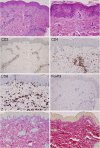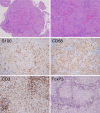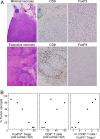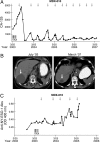Immunologic and clinical effects of antibody blockade of cytotoxic T lymphocyte-associated antigen 4 in previously vaccinated cancer patients
- PMID: 18287062
- PMCID: PMC2268575
- DOI: 10.1073/pnas.0712237105
Immunologic and clinical effects of antibody blockade of cytotoxic T lymphocyte-associated antigen 4 in previously vaccinated cancer patients
Abstract
Cytotoxic T lymphocyte-associated antigen 4 (CTLA-4) functions as a negative regulator of endogenous and vaccine-induced antitumor immunity. The administration of fully human anti-CTLA-4 blocking monoclonal antibodies to advanced-cancer patients increases immune-mediated tumor destruction in some subjects. Nonetheless, patients that respond also frequently manifest serious inflammatory pathologies, raising the possibility that the therapeutic and toxic effects of CTLA-4 blockade might be linked. Here we show that periodic infusions of anti-CTLA-4 antibodies after vaccination with irradiated, autologous tumor cells engineered to secrete GM-CSF (GVAX) generate clinically meaningful antitumor immunity without grade 3 or 4 toxicity in a majority of metastatic melanoma patients. The application of this sequential immunotherapy to advanced ovarian carcinoma patients also revealed that tumor destruction and severe inflammatory pathology could be dissociated, although further refinements are required to increase clinical responses and to minimize toxicity in this population. The extent of therapy-induced tumor necrosis was linearly related to the natural logarithm of the ratio of intratumoral CD8(+) effector T cells to FoxP3(+) regulatory T cells (Tregs) in posttreatment biopsies. Together, these findings help clarify the immunologic and clinical effects of CTLA-4 antibody blockade in previously vaccinated patients and raise the possibility that selective targeting of antitumor Tregs may constitute a complementary strategy for combination therapy.
Conflict of interest statement
Conflict of interest statement: I.L. and A. Korman are employees of Medarex, Inc. J.P.A. is a consultant to Medarex, Inc. F.S.H. has served as a nonpaid consultant for Medarex, Inc., and Bristol–Myers Squibb. F.S.H. receives support for company-sponsored trials from Medarex, Inc., and Bristol–Myers Squibb.
Figures





References
Publication types
MeSH terms
Substances
Grants and funding
LinkOut - more resources
Full Text Sources
Other Literature Sources
Medical
Molecular Biology Databases
Research Materials

